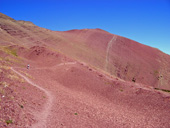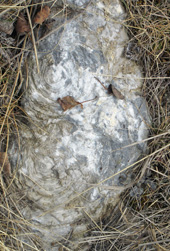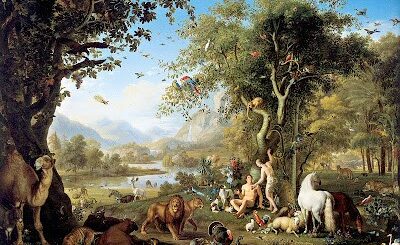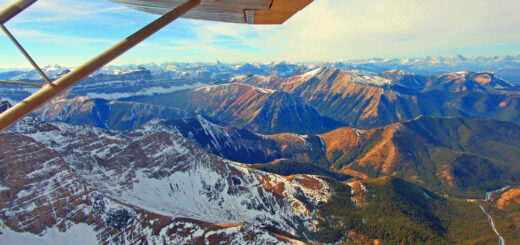Building of the Rocky Mountains.
Rocky Mountains Biosphere, Part 2a.

In our little corner of the Rocky Mountains, it appears that the Prairies come in from the east only to be confronted by a sheer wall of rock. This is particularly noticeable at the Livingstone range and the front of Waterton Lakes National Park.
Where the prairies met the Rocky Mountains. Photo by Lois Everett.
In the distant past, all the ancient rivers drained into the Pacific Ocean, running from east to west. Nowadays, in Alberta, most of our rivers run away from the Continental divide into the Arctic Ocean. The ancient system of drainage deposited great amounts of sand, silt, and limestone to-be into the western edge of the Ocean.
The Columbia Mountains and the Rockies were built from southwest to northeast, beginning about 185 million years ago in the western Columbias and ending about 55 million years ago in the eastern foothills of the Rockies. First came a long period of sediment deposition, followed by a shorter period of mountain-building. Throughout this time—1.7 billion years altogether—the movement of the world’s crustal plates played a key role. (Ben Gadd 2008)).
Ben Gadd 2008 wrote a book well worth reading about the Canadian Rockies. It also has a practical side as he takes you around the Rockies as a car ride viewing the evidence. Within its pages, he describes the formation of the Rocky Mountains as follows.
Imagine that the flat-lying sedimentary rock of western Canada is the rug, and the underlying metamorphic rock of the basement is the hardwood floor. Shoved northeastward by terranes colliding with North America, the rug-like sedimentary layer slides along over the floor-like basement. The sedimentary layer contracts and wrinkles into folds. In places, it breaks (it faults), and slabs of rock kilometers thick and many kilometers in size slide up and over one another, a process known as thrust faulting.(Ben Gadd 2008).
As a student, I have a great interest in items of beauty and wonderment that we have observed and all our posts will show this bias. For more learned information please follow the links supplied
Canadian Rockies Geology Road Tours by Ben Gadd (January 19, 2008): Books – Amazon.ca

To me, one of fascinations and beauty of our local Mountains is the multitude of colors. The red, orange, and yellow colors come from the presence of iron when oxidized. The green color is due to the iron being reduced. These beautiful sediments were deposited in an inland sea, at the southern end of the Canadian Rockies in the Waterton area. These are the oldest sedimentary layers in the Columbia Mountains, possibly, eight to nine kilometers thick.

These colorful sediments began as tiny crystals of calcite, or of a similar mineral called aragonite, produced inside cyanobacteria. Whether in the plankton or growing in colonies on the seabed, countless tiny cyanobacterial cells released their calcite/aragonite crystals as they died. This rock is mostly argillite, a very hard mud. (Ben Gadd 1964).
Aragonite forms naturally in almost all mollusk shells, and as a calcareous coral endoskeleton. Because the mineral deposition in mollusk shells is strongly biologically controlled, some crystal forms are distinctively different from those of inorganic aragonite. Several marine animals are made of Aragonite! In a rare occurrence, extinct ammonite shells (which are composed of Aragonite) can naturally become iridescent. This unusual mineral creation is referred to as Ammonite and is currently only found in the Rocky Mountains of North America. (Ben Gadd 2008).
Other exciting finds among the creeks are bit and pieces of ancient coral reefs, or should I say Sponge reefs? There is a lot for me to learn. Also one will come across big rocks composed of Stromatolite fossils. More about these important fossils in a later post.




